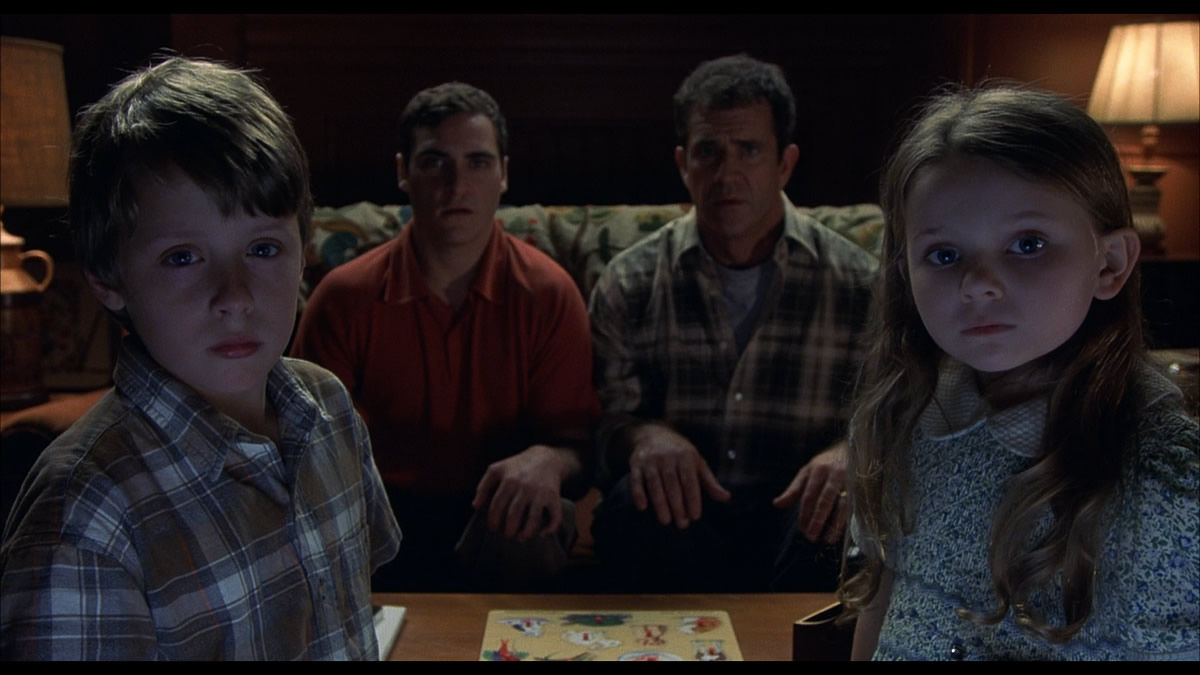Welcome to our Colossus Movie Guide for Signs. This guide contains everything you need to understand the film. Dive into our detailed library of content, covering key aspects of the movie. We encourage your comments to help us create the best possible guide. Thank you!
What is Signs about?

Signs explores the role that faith, family, and fear play in our lives. The alien invaders are there for thrills and tension, but they serve a much grander purpose in regards to those themes. Once you strip away the extraterrestrial elements, you’re left with a family that’s grieving the loss of a matriarch, that feels lost in the wake of life’s cruelty. The family’s foundation, Graham, has lost his faith (as Shyamalan discusses in this great interview with The Ringer). Life feels aimless and meaningless after losing his wife to a car accident. And his family is in a state of stasis because of it.
But the aliens shake everyone to their very cores, forcing them to reevaluate themselves and their place in the universe. When nothing makes sense, the most inexplicable event imaginable strangely puts everything into perspective. Thus, the movie becomes a metaphor for the human experience. The aliens just are plot devices—they represent something greater, something unknowable. The aliens embody the cryptic nature of life, the merciless reality that awaits us on the other side of trauma.
Graham and his family’s journey with the aliens defamiliarizes their collective overcoming of grief. There’s an old adage of “everything happens for a reason” that feels ruthless and sadistic when something truly terrible happens to you. But Signs argues that even the most painful experiences will eventually lead us toward greener paths. Something as small as Bo’s scattered glasses of water or Merrill’s failed baseball career come around to have meaning and purpose in the end. Those small occurrences are gateways for someone like Graham to regain his faith in the world, to understand the good he can do in this world and the positive force he can become in the wake of his wife’s death. Her departure fueled a much greater sense of purpose in Graham than he could have every imagined.
Movie Guide table of contents
Cast
- Mel Gibson – Father Graham Hess
- Joaquin Phoenix – Merrill Hess
- Rory Culkin – Morgan Hess
- Abigail Breslin – Bo Hess
- Cherry Jones – Caroline Paski
- Patricia Kalember – Colleen Hess
- Ted Sutton – SFC Cunningham
- Merritt Wever – Tracey Abernathy
- Lanny Flaherty – Carl Nathan
- Marion McCorry – Mrs. Nathan
- Michael Showalter – Lionel Prichard
- M. Night Shyamalan – Writer, director, Ray Reddy
The ending of Signs explained
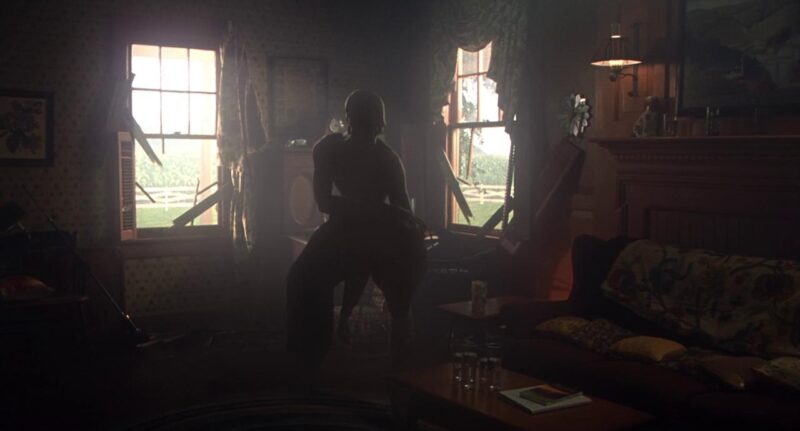
A recap of the ending
After discovering the truth about the aliens at Reddy’s house, Graham returns home to alert and protect his family. He provides two options: to go to the lake and trust Reddy’s theory that aliens don’t like water (the big twist of the movie), or board up the house and stay put. After a family vote, which includes two votes for Graham because of his dead wife, they decide to stay in the house. So while Graham and his brother Merrill board up the house, his daughter Bo and his son Morgan watch the news and find out that extraterrestrial life could be seen floating above 274 cities worldwide. Which, according to their crop circle, means the aliens are nearby.
Before nightfall reaches, they decide to have their potentially last family meal, for which everybody chooses their favorite foods. At the table, Graham holds his children and brother as they all cry, clearly dealing with both the impending attack and coming to terms with how much Colleen’s death has affected them. Then, suddenly, the baby monitor makes the dreaded noise, and the television goes silent. The aliens are here.
When they hear the invaders breaking into their home, Graham’s family hides to the basement. Despite efforts to barricade the door, an alien reaches through a coal chute. Amid the chaos, Morgan suffers an asthma attack and they’re without his inhaler. In an incredibly emotional scene, Graham forces himself to stand strong and help Morgan breathe while Merrill and Bo look on. He keeps Morgan calm all night until morning reaches.
Come morning, the family learns from a radio broadcast that humans have found a way to fight back, forcing the aliens to retreat. Sensing a brief respite, the family leaves their basement sanctuary to find medicine for Morgan—but the danger isn’t over yet. Soon they come face to face with an alien that grabs Morgan and exposes him to poisonous gas. In the face of this dire threat, Graham recalls his deceased wife’s last words to “swing away,” an instruction he aims at Merrill. Armed with his old baseball bat, Merrill fights off the alien. In the process, he discovers the creature’s weakness: water. The unfinished glasses of water Bo has left around the house turn out to be an unexpected weapon, forcing the alien to submit.
While Merrill battles the alien, Graham administers the asthma medicine to Morgan, who quickly recovers. The silver lining in this terrifying ordeal is that Morgan’s asthma had prevented him from inhaling the alien’s poisonous gas.
The culmination of these events, and the realization that his wife’s final words held a deeper meaning, rejuvenates Graham’s lost faith. The movie concludes with the world now in the grip of winter, and Graham once again wearing his clerical robes, preparing for mass, signifying a full circle return to his faith.
Faith, grief, and alien metaphors
Signs uses the extraterrestrial threat to symbolically parallel and explore Graham’s crisis of faith and his journey through grief. The aliens externalize Graham’s internal conflict and embody the inexplicable randomness of life he grapples with after Colleen’s death. The crop circles and the uninvited invasion of the aliens embody the sudden, unwelcome intrusion of grief and crisis in Graham’s life.
In this sense, Graham’s retreat from faith represents a form of denial—or, perhaps a better word would be avoidance. In the face of such tragedy, Graham’s faith points him in the right direction. Part of being spiritual and religious is trusting the unknown and accepting that there’s a plan for everything. It might seem unpractical or insensitive or downright cruel—but there’s a reason for everything. Each and every moment of your life is another step towards achieving spiritual transcendence, to recognizing your place in the grand scheme of things. You and everyone around you are small pieces of this ever-evolving puzzle. But incredibly important pieces.
So, the ending can be seen as Graham’s realization of the fundamental facet of faith. To someone like Graham who’s in grief, the aliens are initially indecipherable and threatening—just like God appeared in the wake of his wife’s death. However, the climactic scene of Signs recontextualizes these threats and the seemingly random tragedies of life. The “swing away” moment serves as a pivotal turning point in Graham’s journey with faith and grief. These words, whispered by his dying wife, are frozen in time—they are spoken to Graham, yet don’t penetrate. They reverberate in this empty space that exists in the recesses of Graham’s emotionally debilitated mind.
Yet, when his family is threatened by this alien, his mind unfreezes, and these words transform into a message of salvation. The “swing away” instruction prompts Merrill to use his baseball bat—a symbol of his unfulfilled dreams—to fight the alien, setting off a domino effect. The glasses of water that Bo leaves around the house, initially a quirky and frustrating habit, become deadly weapons against the alien. And Morgan’s asthma, a condition that causes him great suffering, ends up saving his life by preventing him from inhaling the alien’s poisonous gas.
In this light, the “swing away” moment acts as a metaphor for finding meaning and purpose in seeming randomness, suffering, and the unfairness of life. It becomes the glue that connects the entire family together in a moment of extreme peril. Nobody’s quirks or flaws or failed dreams go to waste—they all end up having purpose. It’s a moment where invisible hands are navigating the situation, and all it required was faith. Faith that something greater does exist and will help you find the light in the end. Graham’s renewed faith hinges on this realization that even in the most devastating circumstances, there may be a larger purpose at work—a plan that we may not immediately understand.
Why is the movie called Signs?
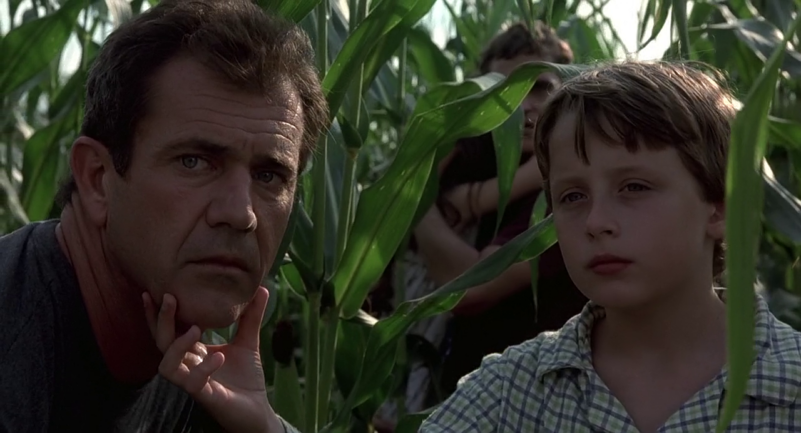
The title Signs is rich in its implications and meaning. At first glance, the word “signs” is a clear reference to the mysterious crop circles that appear on Graham’s farm and across the world. But as the story progresses, it becomes clear that these physical “signs” are just the tip of the iceberg—there’s a much deeper symbolic play at hand by M. Night Shyamalan.
The title becomes a direct reflection of the film’s central themes: faith, destiny, and the search for meaning amidst chaos and grief. Throughout the film, we see a complex interplay of physical and metaphorical “signs” that the characters encounter and interpret. The struggle to understand and the catharsis of ultimate understanding have profound, intangible effects on their lives as they struggle to overcome grief and make sense of the seemingly cruel world around them.
Graham, a former Episcopal priest who quit his job and can no longer make sense of his faith, is a key character through whom the deeper connotations of the title are explored. For Graham, the extraterrestrial signs initially represent random events that echo the seeming randomness and savagery of his wife’s death. However, as the movie unfolds, these signs become catalysts for his spiritual journey and the reclaiming of his faith.
Graham’s path from skepticism to belief mirrors humanity’s age-old (and arguably impossible and never-ending) quest for meaning. As humans, we constantly seek patterns in our lives to make sense of the world, to understand our purpose, and to navigate adversity. Graham’s spiritual struggle embodies this universal quest. The “signs” in the film, therefore, symbolize life’s many mysteries and uncertainties that challenge us, as well as the potential meanings and purpose that we may find amidst these challenges, thereby helping us to grow and transform.
Many people determine these “signs” as messages from a higher power or the universe. Thus, the film poses profound questions about faith and destiny. Are our lives just a series of random, unrelated events? Or are they governed by some grand, divine plan? Are the trials and tribulations we face meaningless, or are they “signs” that steer us toward our ultimate purpose and growth? The title Signs, in this context, encapsulates these existential questions.
A pivotal moment in the film that sheds light on this interpretation is the “swing away” scene. The dying words of Graham’s wife—seen as a cryptic sign—eventually become a powerful message of hope, instrumental in the survival of his family. This moment reveals that what may seem like senseless suffering could carry profound meanings and that “signs” may sometimes come in the most unexpected forms.
By the end of the film, the once skeptic Graham comes to see the “signs” in his life not as mere coincidences, but as divine interventions shaping his destiny—and sometimes, they’re seen as miracles. This transformation underscores the deeper implications of the film’s title. It suggests that signs are not just external, physical phenomena—they are also deeply personal and subjective experiences that reflect our inner spiritual journey. Whether we invent these signs or whether they are orchestrated by a higher being, these “signs” belong to us. We understand them and their purpose in the moment. And whatever meaning we assign to them is part of our individual journeys.
The themes and meaning of Signs
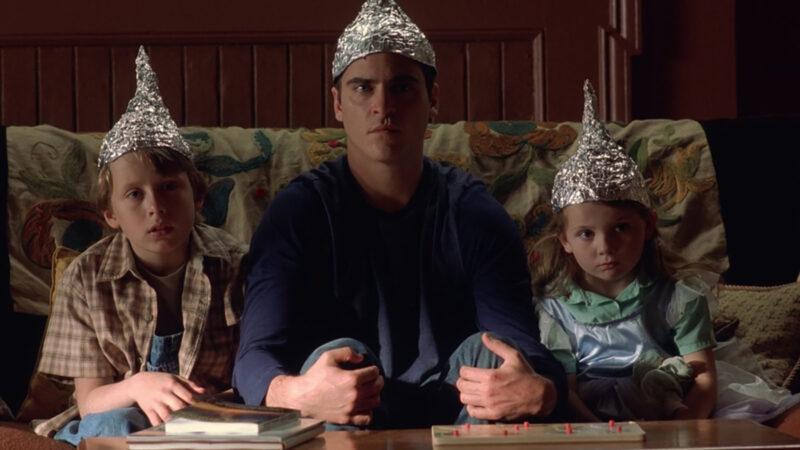
People are connected by their trauma
The theme of shared trauma is interwoven by Shyamalan with the broader narrative of humanity’s collective quest for meaning. The crop circles don’t just appear in Graham’s backyard—they manifest all over the world. Thus, these crop circles don’t just affect one family that’s struggling to understanding the meaning of life, but become broader metaphors for the collective traumatic experience that affects humanity as a whole.
The presence of crop circles all over the world means that many people are forced to deal with these “signs” just like Graham and his family. Thus, everybody’s specific struggles are guided by how they interpret these signs. Some view the crop circles with skepticism or dismiss them as elaborate hoaxes, while others interpret them as signals of an impending extraterrestrial invasion. And many others, like Graham, are forced to consider a higher power is at work, and that there is a reason for anything and everything that happens—including his wife’s death. The diverse responses highlight how people’s unique histories, beliefs, and emotional states shape their interpretations of and reactions to trauma.
Graham’s personal trauma, the loss of his wife, makes him view the “signs” through a lens of skepticism and bitterness. However, as the narrative progresses, his interpretation shifts, and he perceives the signs as a conduit to restore his lost faith and heal from his personal trauma. The shift in Graham’s perspective reveals an important aspect of trauma processing: that it can potentially lead to personal growth and transformation when we are able to find meaning in it. Everybody else in the world that’s forced to react to an impending invasion goes through some version of that back-and-forth narrative.
In this sense, the act of trauma unites people and allows them to empathize with those experiencing a similar plight. Shyamalan’s film suggests that, much like the crop circles, trauma—or, perhaps more accurately, the reality of unknowing—can serve as a catalyst for communal connection and shared understanding. The global panic and fear resulting from the extraterrestrial “signs” bring people together, compelling them to share their fears and hopes, thus highlighting the potential of shared trauma to engender collective empathy and solidarity.
Predestination and the paradox of divine providence
Predestination: the idea that a higher power guides the events of our lives. Predestination suggests that all events, even the most tragic ones, like the loss of your wife or mother, are part of a divine plan. Predestination is an integral part of Graham’s faith, and by nature is is asked to accept when terrible things like his wife’s death happen. But reality is much different. As we see from the film’s beginning to end, predestination can offer both solace and distress to those grappling with the concept.
The reassurance comes from the belief that there’s an ultimate purpose to every occurrence, that the universe isn’t random or chaotic, but rather organized and purposeful—this represents Graham’s state of mind by movie’s end. This idea provides comfort, especially in times of crisis or grief: even in the midst of the most painful experiences, there is an underlying purpose we have yet to understand.
But predestination also implies a lack of control over one’s own life. Which is distressing. If you truly believe in predestination, it can provoke feelings of helplessness and frustration—especially when people are confronted with tragic or unjust circumstances that seem beyond their control. In Graham’s case, it’s not even that he questions his faith or his belief in God. It’s that God suddenly seems cruel and relentless in ways he never imagined. And that disrupts his whole understanding of existence. For many like Graham, the idea of divine providence becomes source of existential crisis, as it raises challenging questions about human autonomy and free will.
However, as the film unfolds, Graham is confronted with a series of events that appear to be part of a larger plan outside his control—yet designed entirely for him. His daughter’s odd habit of leaving glasses of water around the house, his son’s asthma, and his brother’s baseball skills, seemingly random elements of their lives, ultimately come together to save the family from the alien threat. All of these things coming together to save Graham’s family from the alien at the end of the movie could have been mere coincidence. But Graham, who is struggling to understand the nature of his faith and the ultimate direction provided by God, determines these moments as diving signs. In this moment, predestination finally makes sense and brings the much-needed comfort he’d been searching for ever since his wife’s death.
Important motifs in Signs
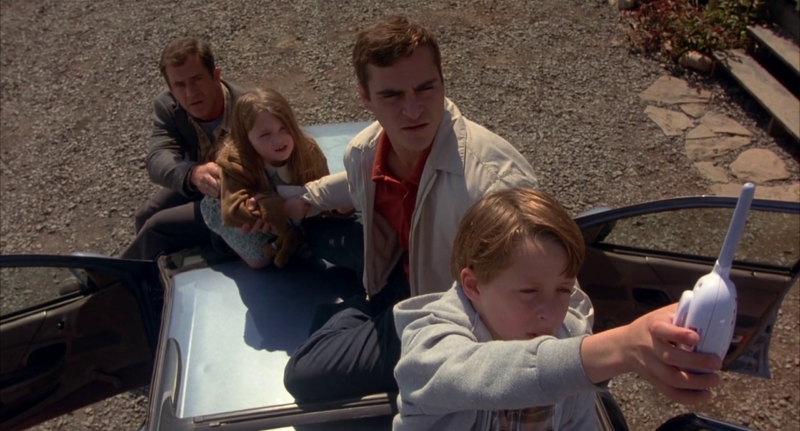
Water
One of the most prominent motifs in Signs is water. What seems like nothing than a quirk of Bo—who leaves half-finished glasses of water lying around the house, deeming them “contaminated” after a few sips—ends up having immense consequences and carrying much symbolic weight. Her strange practice, in the end, helps Merrill defeat the alien that’s attacking his family. Bo has no reason for leaving glasses of water everywhere, yet it becomes a “sign” for how to defeat this impending villain.
As the film progresses, water becomes a symbol of purification and protection, a counter to the alien invasion that terrifies the world. The aliens, we learn, are harmed by water, suggesting a vulnerability to elements that are basic and natural to human life. In religious contexts, water is often seen as a purifying force, used in baptisms and other rituals. Its use in the movie could also be seen as an assertion of the resilience and protection that ordinary aspects of our world can offer in the face of an extraordinary threat.
Crop circles
Crop circles first appear as mysterious, inexplicable signs in the Hess family’s cornfield. Throughout the world, these crop circles trigger fear, curiosity, speculation. They essentially circles function as a symbol of the unknown, the inexplicable, and the otherworldly—not just to Graham and his family, but the entire human race. As we discussed in the themes section, these crop circles serve as “signs” in different ways to everyone.
They also represent the idea of signs in a literal sense—physical manifestations of a non-human intelligence. The crop circles serve as a visual reminder of the larger universe that the Hess family, and indeed all of humanity, are a part of. They are a call to look beyond our immediate realities and confront the unknown, the incomprehensible, and the bigger questions of existence.
Asthma
Morgan’s asthma symbolizes vulnerability and the our susceptibility to harm. Morgan’s asthma attacks are moments of intense distress for the family, reinforcing the theme of trauma and the shared burden of it. Interestingly, this apparent weakness becomes a form of protection during the climactic confrontation with the alien. Morgan’s contracted airways prevent him from inhaling the alien’s toxic gas, turning his vulnerability into a means of survival. Thus, this motif subtly emphasizes that sometimes our perceived weaknesses may carry hidden strengths.
Faith and doubt
Faith and doubt is a motif that pervades the movie—especially Graham. His journey from a priest who loses faith after his wife’s tragic death to a man who regains it in the face of an extraterrestrial threat is the movie’s main narrative arcs. The persistent interplay between faith and doubt in the film underscores the struggle to find meaning and purpose in a world that often feels random and cruel. The motif explores how personal tragedy can shatter belief, and yet, paradoxically, the most inexplicable events can restore it.
The baby monitor
The baby monitor, used by Morgan to detect alien communications, is a crucial motif that signifies connection and communication. It underscores the theme of human desire to understand and make sense of the world around us, even when faced with something as incomprehensible as an alien invasion. The monitor serves as a literal device to tune into the unknown and the unseen, representing our innate curiosity and resilience. It also stands as a metaphor for our human need to listen—to each other, to the universe, and to the signs we’re given, however mysterious or cryptic they may be.
Questions & answers about Signs
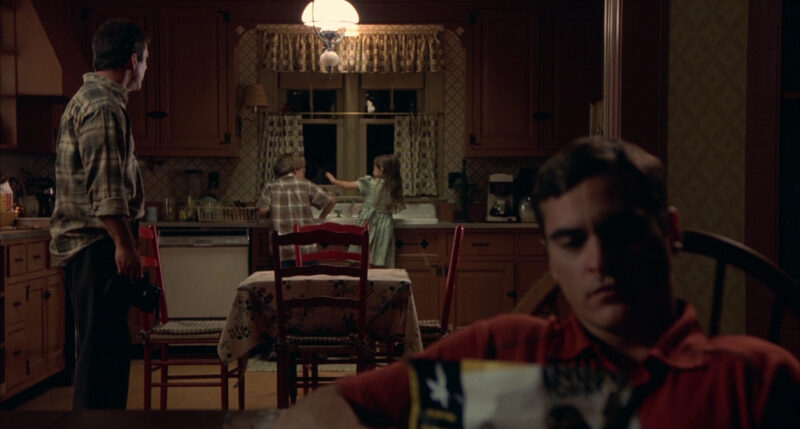
Why did the aliens come to Earth if they hate water?
The question about why the aliens chose to invade Earth being covered by three-fourths water, which harms them, is left unanswered in Signs. Some viewers interpret this as a flaw in the movie’s plot, but others see it as a deliberate choice by Shyamalan to emphasize the themes of faith and fate. There are a few theories we can explore to make this plot contrivance a bit more sensible (my favorite theory is the last one, by the way).
From a thematic perspective, water could be seen as a deliberate metaphor or symbol in the case of the aliens. Often when it comes to religion, water is a symbol of life, purity, renewal. Therefore, the aliens’ aversion to water might represent their inherent opposition to these qualities. This lends to the theory that the aliens are actually demons (see the next question for more info on that).
From a pure plot perspective, we might consider that they were desperate or that Earth had other resources they needed, and that they intended to stay away from the parts covered in water. It’s also likely that the aliens had never encountered water and had no idea it would be a weakness. Both seem like reasonable theories—but, again, the movie gives no indication of either being the right answer.
The most symbolic answer I can provide (which means it’s the one I like the most) is that this piece of information was set in place to keep in line with the movie’s themes, as their arrival and their weakness might be seen as part of a larger, divine plan—a set of “signs” set in motion to restore Graham’s faith. Shyamalan isn’t afraid to make blatantly symbolic decisions like these, even if people perceive such a decision to be a dumb narrative device or a plot hole (it’s a quirk he inherited from his favorite director, Alfred Hitchcock, and part of why I love him as a filmmaker).
Are the aliens really demons?
This answer is tangential to the previous question, as it requires us to think about the aliens in a symbolic sense rather than a literal one. It’s purely left up to the viewer to interpret—purposefully so, as part of Shyamalan’s intentions, because this ambiguity aligns with the film’s themes of faith, doubt, and interpretation of signs.
The association many people have made between the aliens and demons may stem from their harmful intent, their aversion to water (a purifying element in many religions), and the fear and chaos they cause. However, they also have physical and technological characteristics associated with conventional depictions of extraterrestrials, like spaceships and advanced technology. Then again, there’s no reason to believe these two theories are mutually exclusive—they can serve both a literal and symbolic purpose.
This ambiguity invites viewers to reflect on their own beliefs and perceptions, much as the characters in the movie grapple with understanding the “signs” they encounter. It underscores the idea that our interpretation of events and signs is deeply influenced by our beliefs and experiences.
What do the crop circles represent?
In Signs, the crop circles first appear as mysterious phenomena that thrust the Hess family (and the rest of the world) into a state of uncertainty and fear. They are literal signs of the aliens’ presence and intent. However, they also hold symbolic significance tied to the film’s broader themes.
Symbolically, the crop circles represent the unknown and the inexplicable—a visual manifestation of a reality beyond human understanding. They force characters, particularly Graham, to confront questions of faith, purpose, and destiny. The anxiety and speculation these crop circles trigger reflect human fears and uncertainties about what lies beyond our understanding and control.
The circles can also symbolize the idea that we are part of a larger universe, that there are forces at work beyond our immediate reality. They act as a catalyst for the characters’ growth and understanding of their place in the world and the cosmos.
What does the “swing away” line represent?
The “swing away” line is a pivotal moment in Signs and is rich with symbolic significance—for both Graham and Merrill. When Graham remembers this line from his wife Colleen during the climactic confrontation with the alien, he understands it as a sign or instruction to his brother Merrill to use his baseball bat to attack the alien. This moment represents the film’s exploration of faith, destiny, and the idea that seemingly random or tragic events might be part of a larger plan
The “swing away” line symbolizes the turning point in Graham’s journey of faith, when he chooses to see this moment not as a random coincidence but as a divinely orchestrated sign. It underscores the film’s message that faith can be restored in the face of the unknown and that the signs we need often come in unexpected ways.
It also suggests the notion that our past experiences and skills can serve us in unpredictable ways. Merrill’s past as a baseball player, which might have seemed irrelevant in the face of an alien invasion, proves to be crucial in their survival. And because he’s a failed baseball player, he’s able to channel the frustration that stemmed from his lackluster career. This can be seen as an affirmation of the unique value and purpose of every individual’s life and experiences.
Now it’s your turn
Have more unanswered questions about Signs? Are there themes or motifs we missed? Is there more to explain about the ending? Please post your questions and thoughts in the comments section! We’ll do our best to address every one of them. If we like what you have to say, you could become part of our movie guide!

